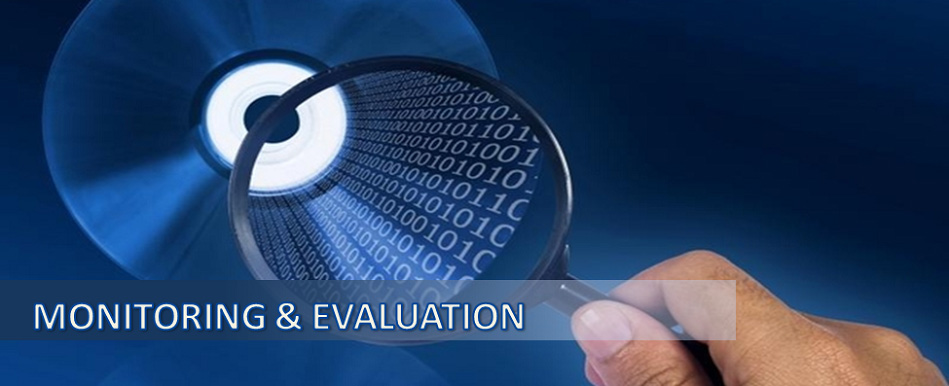
Our Understanding about M&E:
Monitoring is the ongoing collection and analysis of data that informs project managers if progress toward established goals is being achieved. Evaluation is a comprehensive appraisal that looks at the long-term impacts of a project and exposes what worked, what did not, and what should be done differently in future projects.
What Do We Do?
- Perform research—using qualitative fieldwork and theoretical perspectives from psychology, economics, and organizational behavior—to identify policy problems and promising approaches.
- Conduct evaluation—using random assignment, non-experimental designs, and qualitative methods to establish whether programs work, test innovations, and determine cost-effectiveness.
- Design monitoring systems—so program managers implement their programs to achieve maximum impact.

IMPLEMENTING MONITORING & EVALUATION:
When planning for M&E, it is vital to consider whether appropriate funds and staff time can be allocated to it, since M&E is an ongoing process that requires a significant commitment. Another key consideration is who to partner with to design and execute M&E. While external professionals may bring needed expertise, involving community partners is an excellent strategy for involving stakeholders in project management and for demonstrating accountability.
The diagram below outlines a broad step-by-step process for M&E.

MONITORING & EVALUATION FRAMEWORK:
- Logic Model and Indicators: After finalizing a logic model for planning and management purposes, associated indicators should be created in consultation with stakeholders to monitor achievement at every step of the project, from inputs and activities to outputs and outcomes. Indicators should be Specific, Measurable, Achievable, Relevant and Timely (SMART).
- Validate Indicators with Stakeholders: Developing indicators is a key opportunity for community participation. By providing input on the indicators, community members are not only made aware of, but more importantly provide input to, project design and objective setting. This process of vetting indicators helps build ownership and transparency.
- Conduct Baseline Assessment: An assessment of current conditions is necessary in order to create a baseline against which to measure progress over time. For example, one can only effectively gauge an increase in primary school enrollment over time if there is information on initial levels of enrollment at the beginning of the project.
- Set Targets and Scale: After finalizing the list of indicators that will be measured to monitor progress, targets should be set for each indicator. Targets are the goals that you are aiming to achieve by a certain point in time.
- Monitor Inputs, Outputs and Outcomes: A project’s specific data collection cycle will depend on the timeline for its targets, though periodic data collection in line with a company’s quarterly reporting efforts is a good way to integrate community development into business processes. Data collection should ideally be participatory. By involving the community in monitoring, stakeholders can keep abreast of progress and make suggestions for course corrections, while the project partners can benefit from increased support and buy-in as a result of such transparency.
- Consult Stakeholders on Monitoring Results: By reporting performance data gathered through monitoring, a company can meet community expectations for transparency and continue the dialogue about project design, management and performance. Information that is developed from monitoring should be disclosed in a “culturally appropriate” form that is accessible to all external stakeholders (in the local language, perhaps recited on local radio or in community meetings instead of being presented exclusively in written form, etc.).
- Make Project Adjustments: Engaging stakeholders through data collection and reporting will help project managers gain information on how projects should be adjusted to better ensure that goals are consistently being met. Once this information is brought to light, adjustments to the project should be made to improve performance. This is an iterative cycle that should be repeated throughout a project’s life.
- Evaluate Project Impacts: Project evaluation occurs after a project has been completed. It is an analysis that helps to explain why the project did, or did not, produce particular results. Unlike monitoring, it is not used for ongoing management, but focuses on final outcomes. Evaluations can be large scale surveys executed by an external group with statistical and social science expertise, such as a university. Likewise, it can be a small-scale rapid assessment that uses participatory methods, such as group interviews and key informants as well as available data such as case studies. Evaluation can not only help clarify whether costs for a project were justified but also inform decisions on the design and management of future projects and serve as an accountability mechanism.
- Report and Engage Stakeholders: A final step in M&E is to share information on project impacts with shareholders, communities and the public at large through multiple channels. Reporting should not be seen as an end in itself, but rather as an invitation to dialogue with external stakeholders. The company can use M&E to inform the public of project progress and learning’s, as well as to invite feedback on the company’s wider community development efforts.
